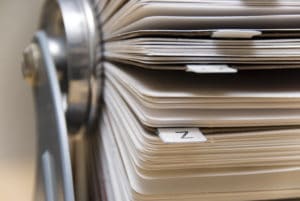Media Database: The Ultimate Guide
A media database is a structured directory of journalist and influencer contact information. This allows
communications professionals to search and find the right people to reach out to when seeking earned
media coverage.
Public relations without a media database is like standing at a microphone. You’re ready to go public with some of the biggest news your organization has ever had. News that is going to change everything. Except, as you look out into a room that should be full of reporters, it’s empty.
There’s no one to hear your news; just your mom, way at the back.
If you don’t have a way to find the right journalists and the means to reach them, no matter how revolutionary, feel-good, or just plain awesome your announcement is, it will never get past your owned channels.
Media contact database. Press database. Media database. Media list. PR list. Whatever name you know it by, it’s a media relations super-tool and integral for PR and communications professionals.
This page is going to delve deep into what a media database is and what it can do for you.
Here’s how we’re going to break it down:

What is a media database?
Simply put, it’s a list of journalists, reporters, and other influencers, like bloggers and social media personalities.
This type of list lets you search by a variety of filters—such as outlet, region, media type—to find the most relevant and best fitting media contacts for your organization or campaign.
Most importantly, a media database provides more than just the people to whom you want to reach out. It also provides the means to reach out aka contact details. The best databases even provide areas of interest and social media links so you can get to know your would-be advocates that much better.
A media database is how you find and connect with your ideal advocate.
Journalists vs Influencers
Journalists can be influencers, but not all influencers are journalists.
Long before the internet came along, journalists were the ones the public turned to for information. They’ve always had the credibility of their outlet and the confidence of their readers.
But we can’t bring up reader confidence without mentioning the proliferation of fake news and the growing narrative that the media is not to be trusted. Indeed, a 2021 Ipsos survey found that only 26% of the populations of the US and Canada think that journalists are trustworthy. Additionally, the 2021 Edelman Trust Barometer found that 59% of the global population thinks that “most news organizations are more concerned with supporting an ideology or political position than informing the public.”
Social media influencers
When people talk about influencers now, more often than not they mean social media influencers. The people on Instagram, TikTok, and YouTube who have the hearts and minds of their followers.
Influencer Marketing Hub defines an influencer as a person who has, “the power to affect the purchasing decisions of others because of his or her authority, knowledge, position, or relationship with his or her audience.”
And, just like journalists, social media influencers belong to varying tiers according to their industry authority. The State of Influencer Marketing 2021: Benchmark Report breaks influencers down into six categories based on following size, ranging from micro-influencer (less than 15,000 followers) to mega-influencer (more than 1 million followers). Each type of influencer has its own allure as a champion for your brand.
Having the right influencer spread your good word can make all the difference.
The ideal advocate
When it comes to spreading your message, both journalists and social media influencers have their advantages. Journalists have the credibility of their profession and the clout of their outlet behind them. Influencers have the trust of their followers and can be a critical word-of-mouth advocate or awareness builder for your organization. An authentic recommendation has more power than you know.
If you aren’t sure which type of influencer is right for you—ask yourself where your audience’s attention is. Is it with traditional journalists or the digital authorities? Once you answer this, simply align your efforts with the channels your audience pays attention to.
Regardless of who your ideal advocate is, make sure your database includes those types of people.
Functionality
A media database helps you search for (and find) the most relevant journalists and influencers. The best ones even have features that allow you to learn about their interests and what they’re writing about. This lets you personalize your outreach and increase the chance of landing that elusive earned media.
MEDIA DATABASE FUNCTIONALITY

Basic
When it comes to functionality, a basic media database will make it easy to search for journalists based on keywords, beat (what they write about), region, type of media (radio, print, and so on), etc. It should also have detailed contact info for them, not just general inbox emails. Ideally, a basic database will also let you save your lists and/or the search criteria for future use.
The provider should also have a research team that constantly reviews, updates, and adds contacts to the database. This eliminates those annoying bounce-backs and missed opportunities, and saves you the headache of trying to stay on top of every media move.
Advanced
PR databases with more advanced functionality may also have distribution capabilities built right in, so you can personalize and send emails to the journalists in your lists. Some also have tracking so you know who opened your email and where they clicked, making follow-up so much easier.
Ultimate
When it comes to the ultimate level of functionality in a media database, you get the means to discover new influencers and really get to know the ones in your lists. You get access to the published articles and social posts of the journalists and influencers you are researching. You’ll know exactly what they’re working on right now, what they’ve covered in the past, and how they’ve done it. Plus, you gain insight into any personal interests or quirks they might have—knowledge you can use to make your pitch stand out.
The better the research you do into the influencers you want advocating for you, the better you can craft and tailor your pitches.
There you have it! Now that you know exactly what a media database is, who’s in it, and what features distinguish the basic from the ultimate, let’s talk about why you need one.
Why you need a media database
As we’ve said, trying to execute a successful public relations campaign without the use of a media database is like talking to an empty room.
Databases give you access to the people who can spread your message.
The journalists and influencers a media database connects you with are gatekeepers. They have the eyes and ears and hearts of your audience. They deliver your message with credibility and—ideally—authority.
You need a media database because, media relations still matters.
Media relations
The world is changing. The way we consume information is changing. And, for PR people, so too is the way we interact with the media gatekeepers.
A bit of context: media relations holds a special place in the world of PR. Plainly put (thanks to Wikipedia), it’s the practice of working with members of the media “for the purpose of informing the public of an organization’s mission, policies and practices in a positive, consistent and credible manner.” And whether you advocate a return to its glory days, or claim that we need to embrace a more modern approach, it’s clear that media relations is essential.
While it’s not quite like it used to be, interacting with those in the media and convincing them to spread your message is still the backbone of what PR people do. Alex Slater, founder and managing director of D.C.-based Clyde Group, agrees: “The core of public relations is relationship building, and it’s based on a mutual respect between journalists and PR practitioners.”
Building relationships with journalists
With a database, you can get back to building long term, mutually beneficial relationships with journalists.
Databases make it easy to find the right people, do your research on them, and reach out to them effectively—even if you’ve never spoken to them before. Whether you’re big or small, an established player or the new kid on the block, a not-for-profit or a financial giant, securing and managing media coverage is a fact of life.
But it’s not easy when the only constant of the media world is that things are in constant upheaval.
- Journalists move around a lot
- Their emails change
- They hardly ever have a physical desk in an office and if they do, they’re hardly ever at it
- They may write for several publications about several subjects
- They may work a specific beat but write articles about a personal area of interest as well
With a media database at your disposal, earning coverage becomes easier, but you still need to know whom to pitch.
How to use a media database
Not all media databases are created equal.
They vary in size, regions served, and data accuracy, among other things. Generally, the way you use a media database is constant across the industry.
(Keep in mind, we know and love our database the best, and it’s the one we spend the most time in, so we’re kind of assuming that everyone else’s works the same way.)
When you log in, you’ll see your dashboard. It will have handy charts on useful things like your recent distributions and who you’ve been targeting. From the dashboard, you begin your search and start building your lists. There are typically three ways to do this:
- Search by beats/topics
- Search by outlets/journalists
- Keyword search
Search by beats/topics
A “beat” is a particular issue, sector, organization, or institution that a reporter specializes in.
Read: Beats vs. areas of interest: how to catch a journalist’s attention
When you search by beat, you identify those journalists who primarily write about a certain topic e.g. oil and gas, semiconductors, or college football. These are the experts, the authorities on your subject, and their audience (aka your audience) listens to them.
Search by outlets/journalists
Sometimes you’ll have a client who is desperate to get some coverage in a specific outlet, whether it be a specialty publication or a top-tier national one. When this is the case, simply search for that outlet and the database will return every single person on its roster. From there, you can drill down to see which ones you should contact.
Likewise, for specific journalists, if you know the name of the person you want to target, simply type it in, make sure they’re in the database, and add them to your list.
Keyword search
Here’s where the best databases set themselves apart.
If you’re having trouble finding suitable media contacts searching by beats or outlets, try the keyword search.
It works like this:
When you type in a term, the database searches the text of articles (this requires the tool be integrated with a media monitoring solution) and identifies who is writing about the keyword(s) for specific topics, industries, or even competitors. Agility PR Solutions has an integrated monitoring service that pulls in millions of articles every day—so you’re searching billions of articles.
This easy-to-use, effective, amazingly useful way to search also makes it simple to identify non-traditional journalists—like bloggers or social media influencers—who may not cover a conventional beat or subject.
Media databases allow for hyper targeting.
Filters make your pitches count. By employing filters like media type, location, job role, publication frequency, news focus, etc., you can drill down to such a depth that you all but guarantee the contacts you find are the most likely to want to hear from you and spread your message.
There’s power in that.
You can also apply filters to a keyword search, which helps when you need to build a niche list. For example, filters let you find journalists who have written about the Oscars but normally cover sports, or influencers who are known for blogging about high-tech but might sometimes dabble in ballet reviews.

Keyword search 2.0
The Agility database has yet another feature that takes keyword search even further: Influencer Streams returns articles AND tweets containing your chosen keyword. But it sets itself apart from Hootsuite and TweetDeck in that it only shows you tweets from journalists and influencers, not just anyone with a Twitter handle. Influencer Streams also lets you interact directly with the journalists you find, retweeting, following, or replying to their posts, thereby making yourself known and establishing a rapport even before you reach out.
First you do the searching, then you build the lists, then it’s all about the…
Distribution
Getting coverage depends on making sure your pitch gets read—that means you must stand out from the 100 other pitches that journalist got today. As a communicator you know that to have a message hit home you need to tailor it to an audience. As Alex Slater says, “Above all, tailor your pitch.”
FREE DOWNLOAD: HOW TO GET JOURNALISTS TO OPEN, CLICK, AND LOVE YOUR EMAIL PITCH
A database makes it simple to create multiple media lists that you can use for different types of pitches or even to spin the same story in a different way to appeal to a niche list of journalists.
By segmenting your database into focused lists of influencers who cover niche topics, your chances of getting coverage increases. The spray-and-pray method is passé and does not work. Journalists are tired of getting pitches that don’t apply to them. All you have to do is look up #PRFail on Twitter and you’ll see what we mean. Nothing irks an influencer more than getting a mass email about something irrelevant to them.
Lucky for you, today’s media databases are further distinguished by also being distribution platforms.
Media databases are powerful tools.
Considering all the benefits, it’s no surprise that databases are ubiquitous among PR agencies and in-house communications teams seeking to gain earned media. But it’s not always sunshine and rainbows. Even seasoned PR professionals can face real challenges when using a database.
Being in the game for as long as we have, we’re familiar with the pitfalls of database use. That’s why we’re sharing the five most common database-use challenges and their solutions.
How to choose a media database
If you’re doing any kind of PR work, you will have to keep track of contact information for multiple journalists and influencers. But do you need to source a media database tool, or can you just keep track of your own lists?
Build vs Buy
The answer to this age-old PR question will depend on a few things, but the biggest factor is the number of journalists and influencers you regularly contact—or hope to contact.
If you’re operating in a relatively small and local information economy, there is probably only a handful of journalists who would ever even consider covering your stories. If this is your situation, it’s safe to say you don’t need a professional grade media database solution.
Maintaining your own lists?
| PRO | CON |
|
|
If, on the other hand, you are operating in a bigger arena (think state-wide, national, or international) or you have multiple different publics you need to reach, then things are different. There may be dozens, hundreds, or even thousands of journalists and influencers who might be interested in covering your stories—but only if you can reach them.
What professional media databases do really well is save you time.
And we all know that for PR and comms folks, time is at a premium.
That’s why a good media database can be your best friend. A good media database does the heavy lifting, the behind-the-scenes, thankless work. All to make sure sure you have the most up-to-date contact details of the most hard-to-find influencer at the most out-of-the-way outlet.
How we manage our media database
At Agility PR Solutions, our research team’s only job is to track down contact details and update the database with the accurate data. They’re hunters and gatherers. They make sure that when you reach out to a journalist or influencer, your email will get where it needs to go.
And for those rare times that you do get a bounce-back, a good database will automatically alert its researchers. The team can then find the correct address and update it. The next time you email that contact, it will get through.
As a communications professional, you’re busy crafting high quality messages. This is your superpower. This is the work that will generate the biggest impact for you. If you’re spending your limited time and energy on the endless task of maintaining a media database…you’re not investing your time well. Please stop.
Investing in the right media database
Now, when it comes time to buy, to choose the database that’s right for you—whether you’re switching providers or it’s your first time subscribing to one—you’re going to want to do your homework before signing.
A great place to start is G2. It will be your best friend when it comes to making informed decisions. It’s a peer-to-peer, business solutions review platform providing verified user reviews from fellow business professionals to help you objectively assess which company and products are best for your organization.
For media databases you’ll want to explore the Media Influencer and Targeting Software section. And if we may be so bold, you can see how Agility PR Solutions compares to other vendors here.
Questions to ask a media database provider
This section is designed to help you ask the right questions so you get a solution that’s right for you. So read on discerning professional.
How many UNIQUE journalists and influencers does the database have in your industry? In your region?
Some database providers will claim huge numbers of contacts but count a single journalist who works for three outlets as three contacts. Beware the bloated database.
Is the database global?
Some databases specialize in core markets, regions, industries, etc. Your business will determine which type of database you require.
How often is contact information updated, new contacts added?
You want the answer to be “as frequently as possible.” Ideally, there’s a research team adding and updating thousands of records every day.
Can you request research into new contacts in a niche market (Harry Potter-loving healthcare writers in Malawi)?
Some database vendors will do custom research and find contacts in a niche market or region—and really amazing ones will do it with a smile, usually within a couple business days.
How easy and intuitive is the tool?
If you need an advanced degree to figure out how to build a list, that’s a red flag. If the user reviews you read on review sites like G2 talk about how simple and straightforward things are, you might have a winner.
Can you save and export lists?
The only right answer is yes.
Is it possible to save search criteria so your lists can be automatically updated with the latest contacts and info?
The biggest issue with maintaining your own list is keeping up with all the media moves. You want a database that lets you save your searches (using keywords and filters, of course) so your lists automagically update without you having to do a thing. And when new journalists do appear in your lists, you’ll see an icon beside their name, so you can know immediately who the new kid in town is, and treat them accordingly.
Are you able to reach out to influencers with personalized pitches directly from the platform?
Is email distribution built in? And what about tracking capabilities? Sending emails to your lists right from the platform is good and useful; what’s even better is also knowing who opened them and what links they clicked on. You want both.
Can you easily format your pitch or add multimedia to it?
It’s so much easier when the answer to these questions is “yes”.
What post-sales support and training is provided?
Is it free or is there an additional cost? Are you given a login and that’s the last you hear from them until it’s time to renew?
What are the payment terms?
Is there room for flexibility? For example, can you pay monthly instead of annually?
Is there an auto-renew clause? (Most have this so make sure you read the fine print.)
Are there references you can consult?
If so, make sure they aren’t handpicked by the vendor. Get the real story on a review site like G2.
For more resources on choosing a media database that’s right for you, read our Ultimate Buyer’s Guide to Media Lists.
Your media database awaits
There’s a lot to consider when it comes to media databases, but what most every PR professional already knows—and what we’ve been trying to tell you over the last 3,500 words or so—is that, bottom line, you need one.
Because no matter how overwhelming it can seem, how many variables there can be—from the database’s size to its contact accuracy to the regions and industries it serves—engaging in public relations without a media database is tricky at best, madness at worst.
We’re here to take away any jitters that come with choosing. With our phenomenal research and support teams—and, of course, our phenomenal database of over 1 million unique contacts itself—we’re here to make sure the Agility PR Solutions media database does in fact become your best friend.




